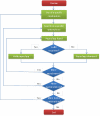Mobile apps in cardiology: review
- PMID: 25098320
- PMCID: PMC4114428
- DOI: 10.2196/mhealth.2737
Mobile apps in cardiology: review
Abstract
Background: Cardiovascular diseases are the deadliest diseases worldwide, with 17.3 million deaths in 2008 alone. Among them, heart-related deaths are of the utmost relevance; a fact easily proven by the 7.25 million deaths caused by ischemic heart disease alone in that year. The latest advances in smartphones and mHealth have been used in the creation of thousands of medical apps related to cardiology, which can help to reduce these mortality rates.
Objective: The aim of this paper is to study the literature on mobile systems and applications currently available, as well as the existing apps related to cardiology from the leading app stores and to then classify the results to see what is available and what is missing, focusing particularly on commercial apps.
Methods: Two reviews have been developed. One is a literature review of mobile systems and applications, retrieved from several databases and systems such as Scopus, PubMed, IEEE Xplore, and Web of Knowledge. The other is a review of mobile apps in the leading app stores, Google play for Android and Apple's App Store for iOS.
Results: Search queries up to May 2013 located 406 papers and 710 apps related to cardiology and heart disease. The most researched section in the literature associated with cardiology is related to mobile heart (and vital signs) monitoring systems and the methods involved in the classification of heart signs in order to detect abnormal functions. Other systems with a significant number of papers are mobile cardiac rehabilitation systems, blood pressure measurement, and systems for the detection of heart failure. The majority of apps for cardiology are heart monitors and medical calculators. Other categories with a high number of apps are those for ECG education and interpretation, cardiology news and journals, blood pressure tracking, heart rate monitoring using an external device, and CPR instruction. There are very few guides on cardiac rehabilitation and apps for the management of the cardiac condition, and there were no apps that assist people who have undergone a heart transplant.
Conclusions: The distribution of work in the field of cardiology apps is considerably disproportionate. Whereas some systems have significant research and apps are available, other important systems lack such research and lack apps, even though the contribution they could provide is significant.
Keywords: apps; cardiology; heart; m-health; mobile applications.
Conflict of interest statement
Conflicts of Interest: Conflicts of Interest: None declared.
Figures





References
-
- World Health Organization Disease and injury regional estimates, cause-specific mortality: regional estimates for 2008. [2013-02-28]. http://www.who.int/gho/mortality_burden_disease/global_burden_disease_DT....
-
- World Health Organization in collaboration with the World Heart Federation and the World Stroke Organization Global Atlas on cardiovascular disease prevention and control. 2011. [2013-07-17]. http://whqlibdoc.who.int/publications/2011/9789241564373_eng.pdf.
-
- World Health Organization Factsheet - Cardiovascular diseases. [2013-05-22]. http://www.who.int/nmh/publications/fact_sheet_cardiovascular_en.pdf.
-
- World Health Organization Cardiovascular diseases. [2013-05-22]. http://www.who.int/cardiovascular_diseases/en/
-
- World Health Organization Fact sheet N° 317. [2013-05-22]. Cardiovascular diseases (CVDs) http://www.who.int/mediacentre/factsheets/fs317/en/
Publication types
LinkOut - more resources
Full Text Sources
Other Literature Sources

